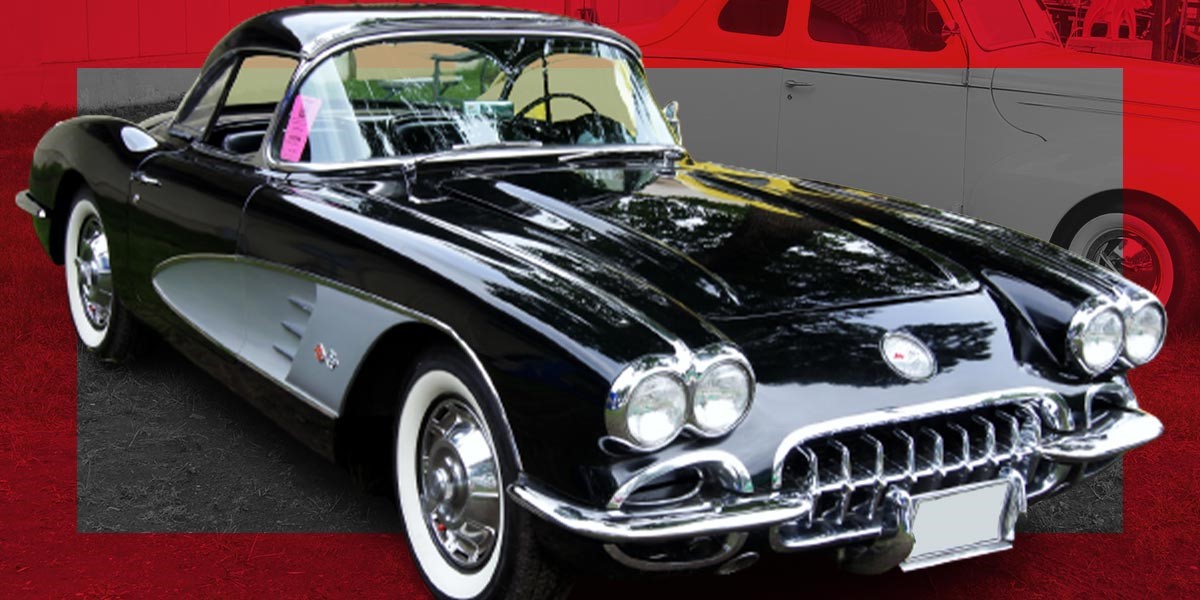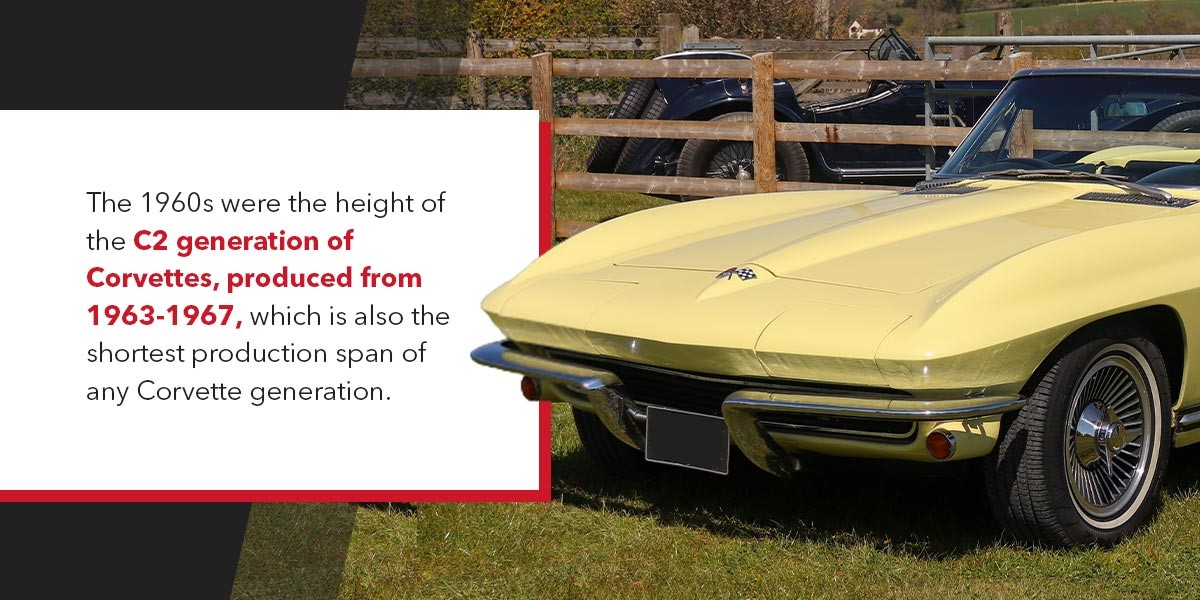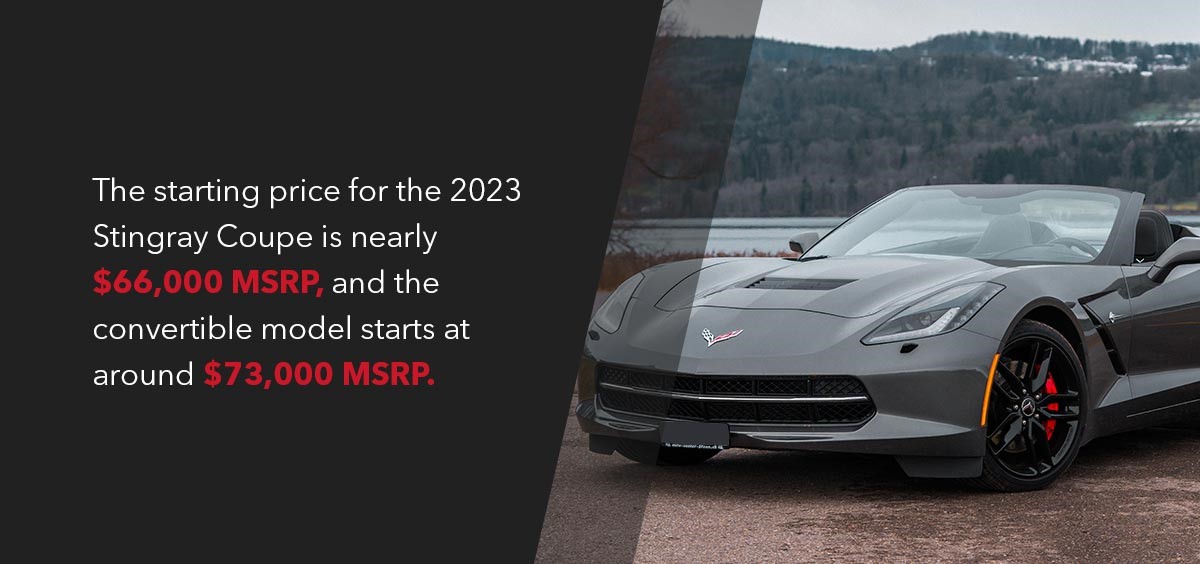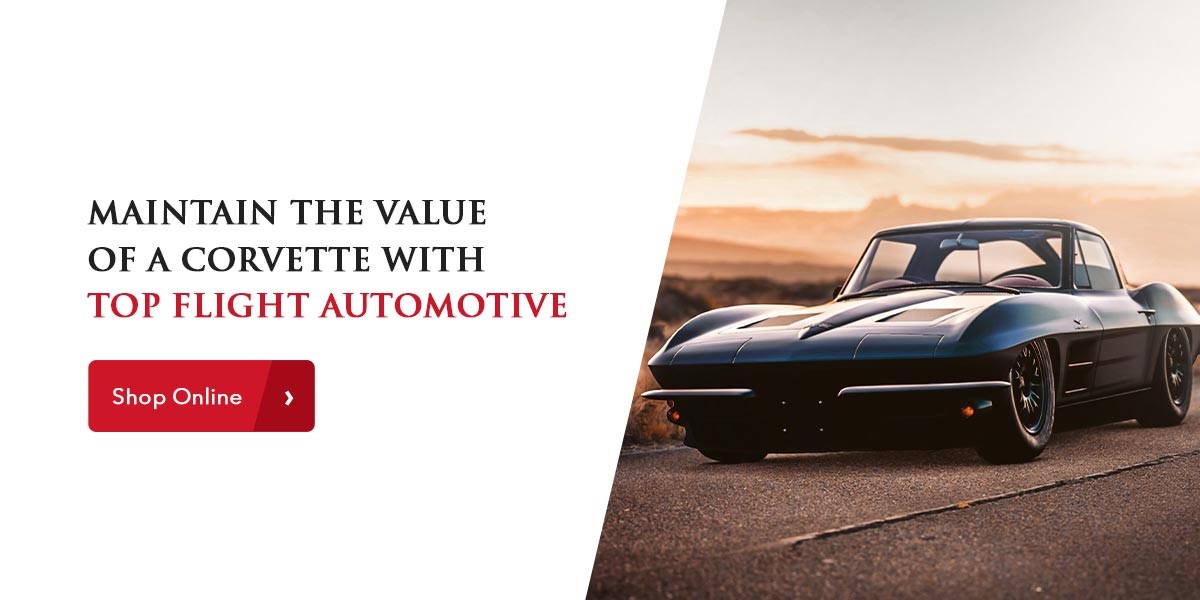
Corvettes are among the most collectible and valuable classic cars because of their history. Corvette features, designs and prices have changed drastically since the 1950s and will continue to do so as long as they’re made. The 1950s-1980s were especially important for the Corvette, as the vehicle was established and refined to grow into a widely known name.
Explore the Corvette cost history through these groundbreaking decades to better understand where the classic Corvette came from.
Corvette Pricing History
Over the past 70 years, the Corvette has become one of the most iconic sports cars. With numerous design changes, the cost of Corvettes has changed significantly, especially between the 1950s and 1980s. While some models were more costly than others, the Corvette has always been a relatively attainable sports car. Many factors can affect the price of a car, including demand, features and model type.
Learn more about the history of Corvette pricing and how the Corvette changed between decades.
1950s
The 1950s brought the birth of the Corvette. Considered a breakthrough car, the first Corvette was released in 1953. Chevy only made 300 Corvettes in the first model year, making it one of the rarest models today. By the following year, Corvettes had attracted so much attention that they fully launched into production in 1954.
The first generation of Corvettes (C1) was produced primarily in the 1950s, from 1953 to 1962. These Corvettes were convertibles with an open cockpit for two passengers. The original ‘53 Corvette had nearly no chrome — instead, it featured a multi-piece, two-toned fiberglass body. The car also featured mesh silver headlight covers and a silver shark-tooth grille. This design lasted several years until it was redesigned to feature chrome bezels around the headlights, wraparound bumpers and a louvered hood. As the ’50s progressed, the Corvette got more refined and efficient.
During the early 1950s, shortages of steel, copper and aluminum caused car prices to rise. Steel and other metals were vital to war efforts years prior, so their use for other products was restricted to reserve material for the war. Though restrictions on these materials were eased around the mid-1950s, prices remained about the same due to significant changes in the cars being produced, like the type of tires or windshields used.
At the time of production, C1 Corvettes sold with a manufacturer’s suggested retail price (MSRP) between $2,000-$4,000. Because of inflation, the cost of a C1 Corvette during production would be equivalent to paying around $24,000-$49,000 for a new car today.
Today’s value of a Corvette manufactured in the 1950s would vary depending on the model year and condition of the car. For example, a ‘53 Corvette in excellent condition could sell for up to $318,000, while a ’59 Corvette in excellent condition may only be worth up to around $83,000. The more unique or rare a Corvette model year is, the more it will be valued today.

1960s
By 1960, Corvettes were almost completely void of chrome. The ‘60s were a significant decade for the Corvette, as the design changed just about every year, each with distinct features and appearances. The 1960 model was the first to include Blackwall tires as a standard and a new grille. The Corvette’s grille underwent several design changes in the ‘60s — first replacing the shark-tooth grille with a black mesh chrome screen, then replacing the mesh screen with thin, horizontal bars in 1963. Then in ’66, an egg-crate insert became the new grille design.
The 1960s were the height of the C2 generation of Corvettes, produced from 1963-1967, which is also the shortest production span of any Corvette generation. Many significant changes to the Corvette design debuted in ‘63, as this year was the first model year of C2 cars.
The ‘63 model was the first closed coupe Corvette, featuring a sleek, aerodynamic look. This model year also introduced the trademark hidden headlights and the contentious rear split window on the ‘63 Sting Ray coupe. The split window was criticized at the time for having limited visibility, though it’s now one of the most collectible models because it’s the only model year with a split rear window.
During this decade, several notable models were released, including the Mako Shark I and II and the Sting Ray. The last of the Sting Ray models were produced in 1967, then the name returned as one word for the ’69 model, the Stingray. The 1968 model was a restyled Mako Shark II, simply named the Shark.
Most notable, however, was the 1967 L88 Coupe. The L88 was designed with the hope that serious racing teams would use it, so it wasn’t promoted to the public. The L88 model was manufactured from 1967-1969 with the ’67 model being the rarest Corvette because only 20 were built.
The cost of a Corvette produced in this decade didn’t have a significant range, between $4,000-$5,000, though the L88 cost closer to $6,600. L88 Corvettes are prized today, especially because only half are known to exist still. Depending on the car’s condition, these models can sell for nearly $4 million.
1970s
The 1970s were the height of the C3 generation of Corvettes. The 1970 model featured design elements from the previous year and included new features like a one-piece roof, stainless steel moldings, a higher windshield, side exhaust, and a crosshatched vent and grille. The 1972 model was the last year the Corvette featured removable windows and chrome bumpers.
In 1973, the Corvette saw its first significant redesign since the ‘68 model. New federal mandates required cars to have 5-mph front bumpers, so the ’73 model featured a new bumper that added about two inches to its length. The front end was V-shaped with a long, sleek urethane plastic nose.
The ’74 model added to those changes with a rear 5-mph bumper, a new tail style, and new trim and scoops. The next year added an exterior luggage rack and was the last year for convertible models until they returned in the mid-1980s. The late 1970s saw few exterior changes to the Corvette besides the ’78 model featuring a fastback roof.
A big factor impacting the cost of cars throughout the 1970s was the increasing gas prices. With high gas prices, car production costs were higher than in previous decades, driving up car price tags. Corvette prices during the ’70s ranged from $5,000 to $10,000, increasing yearly as features changed or advanced. This decade was the most significant price increase yet for Corvettes. Today, Corvettes from the 1970s may be worth between $21,000 and $57,000, depending on model year and condition.
1980s
The early 1980s still belonged to the C3 generation, offering more modern designs that improved aerodynamics and significantly lowered the Corvette’s overall weight. No model-year Corvettes were produced in 1983, the first year in 30 years that a model-year car wasn’t released. This year is often considered somewhat of a gap year, as a new Corvette that was supposed to be released had production delays and ambitious upgrades that pushed back the introduction.
Designated a 1984 model rather than ‘83, Chevrolet debuted its first all-new Corvette model in 15 years to begin the C4 generation of cars. The ’84 Corvette was a modern interpretation of previous models and included several new features like a one-piece removable top, forward-opening clamshell hood, lift-up rear window and a welded, galvanized steel birdcage frame. Despite being a couple of inches wider, this Corvette was smaller in other areas to improve handling.
As mentioned above, the Corvette convertible returned in 1986 with several new features. The late ’80s mostly consisted of technological changes and upgrades to the Corvette, ultimately becoming a trendsetter for new technology.
Because the Corvettes of this decade were significantly more advanced than previous years, the prices reflected those advancements. This decade had another big price increase and a wide range of prices, from around $13,000 for the 1980 model year to around $31,500 for the 1989 model year Corvette.

The Cost of a Corvette Today
Corvettes have remained one of America’s most popular sports cars for seven decades. While the 1950s-1980s were responsible for numerous Corvette classics that many collectors and enthusiasts still cherish, the latest generation of Corvettes has come far from the seemingly advanced 1980s models.
The 2023 C8 Corvette Stingray is available in mid-engine coupe and convertible models featuring a 6.2-liter V-8 engine. The C8 Stingray has experienced such high demand, and with the cost of inflation, it’s consistently selling for over 19% above MSRP. The starting price for the 2023 Stingray Coupe is nearly $66,000 MSRP, and the convertible model starts at around $73,000 MSRP. These prices reflect the 2023 Corvette models at their most basic levels. You can add different packages or options to improve performance or get different features.
For example, the 3LT trim includes a more premium interior than the base model. You could also add the Z51 Performance Package, which adds over $6,300 to the starting price and offers Z51 performance suspension and Brembo brakes, among other features. Chevrolet also offers the 70th Anniversary Special Edition Package, which adds nearly $6,000 to the starting price and comes with special features like 70th anniversary exterior badging and interior plaque, red-colored parts and a unique VIN sequence.
Separate options, accessories or packages you can also add include:
- Premium indoor and outdoor car covers for up to about $1,200
- Competition sport bucket seats for $500
- Chrome lug nuts for $245
- Roof carriers for up to nearly $1,400
- Magnetic selective ride control for less than $2,000
- Front lift with memory for over $2,500
- Carbon Fiber Dual Roof Package for nearly $3,500
- Stingray R Appearance Package for nearly $700
- VIN ending reservation for $5,000
Depending on what you’re looking for, you may purchase one or all of these optional additions. A Corvette with all the packages, optional features and add-ons is considered fully loaded. A fully loaded 2023 Corvette Stingray with 3LT trim and all the packages and extra features costs about $110,000 for the coupe model and about $117,000 for the convertible.
In addition to varying in price based on features and special packages, Corvettes can differ in price depending on where you purchase the vehicle. As mentioned above, the 2023 Stingray has been selling for far above its MSRP. While you may find it for a little over MSRP at one dealership, this Corvette may be significantly marked up somewhere else. Regardless of the features you want to add to your Corvette, be sure to research and shop around to find the right prices.

What to Look for in a Classic Corvette
If you’re considering purchasing a classic Corvette, you’ll want to consider several aspects of the car before making a deal. All classic cars have been used, which means they’re likely to show some wear. While many vintage Corvette owners make repairs, upgrades or modifications to their cars, and you may do the same, you should carefully inspect various parts of the car to understand its current condition.
For example, inspect the car’s body panels for cracks and damage, check the birdcage and frame for rust, look for leaks and check tires and brakes. You may also want a professional inspection before making a deal — it can help you identify any serious issues and what the repair cost may be.
You should also ask the seller for the car’s repair and maintenance records to help you understand the car’s history. The more documentation the seller or previous owner can provide, the better. Asking for this information will also let you know how much the seller knows about the car and whether they know what they’re talking about.
If possible, you should also try to test-drive the car. Use this opportunity to see how the car runs, if at all. Listen for unusual sounds or smells that may indicate something is wrong. Pay attention to how the car feels when you’re driving it to address these areas:
- Is it comfortable?
- Does it vibrate?
- Do the radio and speakers work?
- Can you feel every bump in the road?
- Do the windows work?
These considerations and more can help you determine whether you want this car or should keep looking.
Do your research before purchasing any Corvette, regardless of the model year. Look for something in good condition or that you can afford to repair and maintain. Understanding classic Corvette pricing and values can help you find the right Corvette to buy.

Maintain the Value of a Corvette With Top Flight Automotive
Whether you want a classic Corvette to restore or the newest model, your car will require maintenance, especially to hold its value over time. To help with your parts needs, Top Flight Automotive carries the largest inventory of Corvette parts. With over 40 years of experience and continuous market improvement, we pride ourselves on the ability to help Corvette enthusiasts shop for parts and restore their cars. The parts we offer are high-quality and will meet or exceed the original specifications to ensure you get the desired results.
Start shopping our inventory online to find the Corvette parts you’re looking for.
Sources:
-
- https://www.jdpower.com/cars/1953/chevrolet/corvette/2-door-convertible
- https://www.jdpower.com/cars/1959/chevrolet/corvette/2-door-convertible
- https://www.topflightautomotive.com/blog/how-to-modify-c2-corvette-old-fashioned-look/
- https://www.topflightautomotive.com/blog/the-most-popular-corvette-model-by-decade/
- https://www.sportscarmarket.com/profile/1967-chevrolet-corvette-l88-coupe
- https://www.jdpower.com/cars/1970/chevrolet/corvette/2-door-sport-coupe
- https://www.history.com/news/missing-1983-corvette-model-year
- https://gmauthority.com/blog/2022/03/the-c8-corvette-stingray-is-still-selling-for-over-msrp/
- https://www.topflightautomotive.com/blog/comparing-corvette-trim-levels/
- https://gmauthority.com/blog/2022/07/more-than-two-thirds-of-corvette-stingray-buyers-choosing-z51-package/
- https://www.motorbiscuit.com/fully-loaded-2023-chevy-corvette-cost/
- https://www.topflightautomotive.com/blog/classic-corvette-buying-guide/
- https://www.topflightautomotive.com/products/chevy/corvette/









February 1st, 2024 at 6:16 pm (#)
I am wondering why nothing was discussed about the 1997-2004 C5 models.
February 5th, 2024 at 8:17 am (#)
Gary, With so many generations and variations within generations, we were limited as to what we could pick!